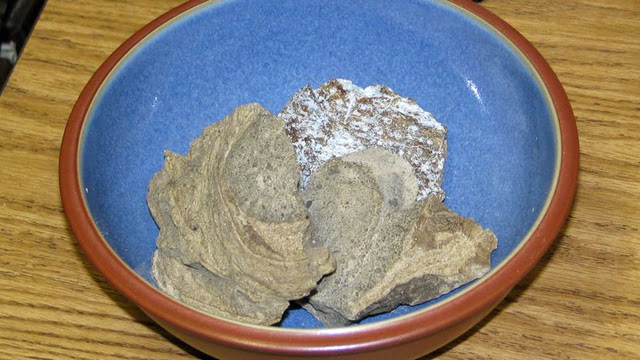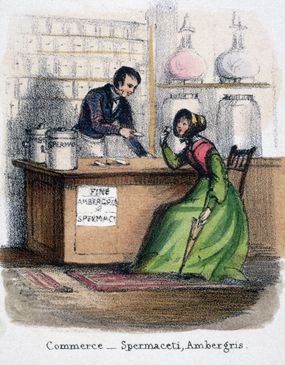Quck answer
Ambergris is a rare and valuable substance produced by sperm whales. It is formed in the whale’s digestive system and expelled as a waste product. It is often referred to as “whale poop,” but in reality, it is a solid, waxy substance. Ambergris is highly valued in the fragrance industry for its unique scent, which is said to enhance the longevity and complexity of perfumes. It is also used in traditional medicine and as a flavoring in food and drinks. The rarity and high demand for ambergris have led to its high price, with some specimens selling for tens of thousands of dollars.
Wild Animals

Ambergris is a valuable substance that comes from the intestines of sperm whales. Although it was traditionally thought to be whale vomit, modern science suggests it is more like a gallstone or poop. In 2016, three fishermen from Oman found a chunk of ambergris weighing 176 pounds, which was worth nearly $3 million. But why is this waxy substance so valuable?
Scientists believe that ambergris is a protective secretion that helps to prevent sperm whales’ digestive tracts from being scratched by squid beaks. The substance used to be thought of as vomit, but now it is believed to be passed out just like fecal matter. When ambergris is initially expelled, it has a terrible smell similar to dried cow dung. However, after floating on the ocean for about a decade, it becomes smooth, waxy, and usually rounded. The smell changes from dung to a musky, earthy, sweet, or indescribable scent that is sought after for use in perfumes.
The Sweet Smell of Ambergris
Ambergris is a vital component of fine perfumes because it helps perfume scent to bind to the skin’s surface instead of quickly evaporating. It is also said to be an aphrodisiac, a homeopathic remedy, and a high-end flavoring for food. Ambergris is a rare find because it comes from sperm whales, and it only washes up on a beach every few years. Additionally, it is found in less than 5 percent of sperm whale carcasses that make it to shore. Although chemists can replicate some of the traits of ambergris synthetically, certain perfume makers still prefer the real thing due to its rarity.

Ambergris has a long history of use, and it was even used as a flavoring for ice cream in the 1660s. However, as it melts, the scent becomes more fecal in nature. Despite its unusual origins, ambergris remains a highly sought-after substance due to its unique properties.
However, in certain nations such as the United States, it is prohibited by law to purchase or sell ambergris due to endangered-species legislation. Nevertheless, this only amplifies its allure in certain circles. According to experts, the current rate for ambergris is approximately $35 per gram, depending on its quality, but legal complications can make finding a buyer challenging. To put it in perspective, as of October 2020, a gram of gold costs around $61 per gram.
Searching for Ambergris
The difficult part is identifying ambergris, particularly as it can be found in almost any coastal region. Most of the time, individuals who bring a piece of waxy substance they discovered on a beach to an expert, fully convinced that they have struck it rich, end up being disappointed as it turns out to be wax, rocks, or the fossilized remains of an animal.
So how can you be certain? Ambergris can be white, gray, black, or a combination of all three. The most valuable color is a pure white or a similar shade since it is the oldest. It possesses a hard, waxy texture and an unusual, pleasant aroma. The least valuable is pure black ambergris, which smells like manure because it is newly expelled. Apart from that, there is little to go on in terms of determining whether the substance is genuinely ambergris or not. However, it should be noted that ambergris is very light in weight, so if it is too heavy to hold comfortably (given its normal size), it is likely not ambergris.
Experts warn against performing the needle test (probing the substance with a heated needle to observe if it transforms into a tar-like liquid) or other tests at home to determine if you have discovered ambergris. This is because these tests are misleading, and if you are unfamiliar with the substance, you may misdiagnose what you have. Some of the substances frequently mistaken for ambergris include fat, degraded oil and mixed polymer, pine resin, amber, and wax.
If you believe that you possess ambergris, a laboratory can perform conclusive tests. Chemists will examine the sample for benzoic acid and cholesterol. If the quantities indicate the presence of ambergris, it will usually be provisionally confirmed as such, even though perfume companies will usually order more chemical tests before purchasing the erstwhile whale product. Some experts, however, argue that the only way to truly identify ambergris is through examination by someone with extensive experience in identifying its appearance, texture, and scent.
Originally Published: Dec 21, 2006
FAQs about Ambergris
What exactly is ambergris?
Ambergris is a round, smooth, waxy substance that is produced in the intestines of large sperm whales. Initially, it is soft and has an unpleasant odor, but after floating in the ocean for about ten years, it hardens and develops a fragrant aroma that makes it a highly sought-after ingredient in luxury perfumes.
Is ambergris valuable?
Yes, ambergris is extremely valuable due to its scarcity. However, in some countries, such as the United States, it is illegal to buy or sell ambergris due to laws protecting endangered species. The value of ambergris varies depending on its quality, but it currently sells for around $35 per gram (compared to gold, which sells for $61 per gram as of October 2020).
Is using ambergris illegal?
In the United States, the buying and selling of ambergris is against the law because it is obtained from whales, which are protected species. Although collecting ambergris does not harm whales, it is illegal because in the past, whales were killed and cut open to obtain ambergris.
What are the uses of ambergris?
Ambergris has been used to create expensive perfumes. Additionally, ancient Arab civilizations used ambergris to make medicines and aphrodisiacs that were believed to cure various diseases and conditions related to the heart, brain, and senses.
How do you identify ambergris?
Identifying ambergris can be challenging, especially as it can be found in almost any coastal area. When people bring a piece of waxy substance they found on the beach to an expert, they often think they have struck gold, but it usually turns out to be wax, rocks, or the fossilized remains of an animal.
Learn More
Related Articles
- How Do Whales Work?
- How Do Squid Work?
- How Do Aphrodisiacs Work?
- What Happens to Whales When They Die?
- How Does Perfume Work?
Sources
- “Ambergris.” The Columbia Encyclopedia, Sixth Edition 2006. http://www.encyclopedia.com/doc/1E1-ambergri.html
- Ambergris Connect. “How to Identify Ambergris.” 2020 (Oct. 19, 2020). https://ambergrisconnect.com/identification.html
- Ambergris New Zealand. “Buy Ambergris.” 2020 (Oct. 19, 2020). https://www.ambergris.co.nz/buy-ambergris
- Guy, Allison. “Whale Poop on Ice Cream? For Some, It’s a Rare Treat.” Oceana. Dec. 2, 2016 (Oct. 19, 2020). https://oceana.org/blog/whale-poop-ice-cream-some-its-rare-treat
- Hrala, Josh. “Lucky Fishermen Have Stumbled Upon a $3 Million Lump of Whale Vomit.” ScienceAlert. Nov. 11, 2016 (Oct. 19, 2020). https://www.sciencealert.com/fisherman-have-just-found-a-us-3-million-lump-of-whale-vomit
- Kilgannon, Corey. “Please Let It Be Whale Vomit, Not Just Sea Junk.” The New York Times. Dec. 18, 2006. http://www.nytimes.com/2006/12/18/nyregion/18whale.html?em&ex=1166763600&en=76cb6223a8315bfb&ei=5087%0A
- Osterloff, Emily. “What is Ambergris?” Natural History Museum. 2020 (Oct. 19, 2020). https://www.nhm.ac.uk/discover/what-is-ambergris.html
FAQ
1. What is ambergris?
Ambergris is a waxy substance that is produced in the digestive system of sperm whales. It is usually grey or black in color and has a unique, musky odor. The substance is often referred to as “whale poop” because it is excreted by the whale.
2. Why is ambergris so valuable?
Ambergris is highly valued in the perfume industry because of its unique scent. It is often described as a combination of musk, tobacco, and wood. The substance is also used to help perfumes last longer on the skin. Because ambergris is rare and difficult to find, it is quite valuable. In fact, a pound of ambergris can sell for tens of thousands of dollars.
3. How is ambergris harvested?
Ambergris is typically found floating in the ocean or washed up on shore. It can be difficult to locate because it is often disguised as a rock or piece of driftwood. Once found, the ambergris is usually removed from the ocean or beach by hand.
4. How is ambergris used in the perfume industry?
Ambergris is used as a fixative in perfumes, which means that it helps the scent last longer on the skin. Perfumers will either use the substance in its natural form or extract the aroma chemicals from it. Because ambergris is so rare and expensive, most perfumes use synthetic substitutes instead.
5. Is it legal to harvest ambergris?
The legality of harvesting ambergris varies by country. In some places, it is illegal to harvest ambergris because it is considered a byproduct of the whaling industry. In other countries, it is legal to harvest ambergris as long as it is done in a sustainable manner.
6. How long has ambergris been used in perfumes?
Ambergris has been used in perfumes for centuries. The ancient Egyptians were known to use the substance in their perfumes, and it was highly valued in Europe during the Renaissance. Today, ambergris is still used in high-end perfumes, but most perfumers use synthetic substitutes instead.
7. Can ambergris be harmful?
Ambergris is not harmful to humans, but it can be harmful to whales. In some cases, the substance can become trapped in the whale’s digestive system and cause blockages or infections. For this reason, some countries have banned the harvesting of ambergris.
8. How much ambergris is produced by a single whale?
It is difficult to say how much ambergris is produced by a single whale because it varies from whale to whale. Some whales may produce only a few ounces of ambergris, while others may produce several pounds. It is also important to note that not all sperm whales produce ambergris.
9. What other uses does ambergris have?
Ambergris is primarily used in the perfume industry, but it has also been used in traditional medicine in some cultures. It has been used to treat a variety of ailments, including headaches, colds, and indigestion. However, there is no scientific evidence to support these claims.
10. Is there a substitute for ambergris?
Yes, there are several synthetic substitutes for ambergris that are used in the perfume industry. These substitutes are often created using a combination of synthetic chemicals and natural ingredients. While they may not have the same unique scent as natural ambergris, they are much more cost-effective and sustainable.





Leave a Reply